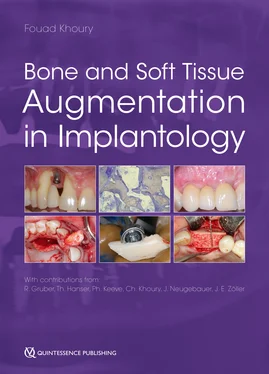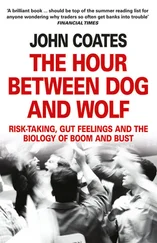He and his co-authors are to be congratulated for this outstanding effort. It is the work of a lifetime put down on paper for all of us to look at, think about, and – most importantly – use in the treatment of our patients. By sharing with us their thoughts about what works and what does not, Dr. Khoury and his team have truly advanced the cause of dentistry. We are grateful and thank them for all of their hard work.
Dennis P. Tarnow, DDS
2006
Professor and Chairman
Department of Periodontology and Implant Dentistry
New York University College of Dentistry
Oral rehabilitation supported by dental implants is today an important column of restorative dentistry. Since the first scientific-based publications in the early 1960s, many improvements in materials and techniques, especially in the augmentative field, have occurred. Increasing patient demand for perfect esthetic and functional rehabilitations, even in difficult anatomical situations, has led to the development of different methods that today allow for the fulfillment of almost all patient desires for a restoration that not only mimics the original anatomical situation, but gives an even better long-term result.
During the past 30 years, different techniques and materials have been recommended for the reconstruction of alveolar defects such as autogenous, allogenic or alloplastic bone grafts. Although the actual evolution of allogenic, xenogenic, and alloplastic materials, in combination with guided tissue regeneration techniques, is progressing from day to day, reproducibility and predictable long-term prognoses are still limited in comparison with autogenous bone, which is still the gold standard. The main problem of xenografts and allografts, especially in block form, is their poor ability for revascularization. This leads to several early as well as late complications and failures in the contaminated oral cavity.
Compared with other bone substitutes, the superiority of autogenous bone has been demonstrated on a biologic, immunologic, and even medicolegal basis. Due to graft morphology, autogenous bone has additional mechanical (cortical) and osteogenic (cancellous) properties, allowing early revascularization and functional remodeling, with low complication rates that are unequalled by any allograft, xenograft, or alloplastic material.
Through better understanding of the biologic processes of bone healing, including cell interaction, vascular supply, and bone remodeling, and in combination with some modifications of the surgical procedures, it is possible today to offer an implant-supported restoration to almost all patients. Alveolar bone is reconstructed in a safe and reproducible manner, even in cases of severe bone loss, so that, following prosthetic planning, a secure and correct implant insertion can be performed. Long-term results of such implants inserted in regenerated bone are providing similar success rates to implants inserted in non-grafted bone.
Different techniques and modifications for augmentation with intraorally harvested bone grafts have been developed over the past three decades with predictable long-term results. These techniques cover almost all situations, starting with a minimally invasive approach with locally harvested bone grafts up to the extremely complicated 3D reconstruction of the whole maxilla and/or mandible.
This is the third book I have edited on bone augmentation in oral implantology. The first one was published in 2006 in English, and the second came out in 2009/2010 in more than 10 languages. In this new edition on bone augmentation and soft tissue management in oral implantology, the focus is principally on the techniques that were developed and modified at our hospital over the past three decades and documented long term by our team.
The first chapter deals with the biology of bone healing especially after grafting procedures, and the second with descriptions of diagnostics and treatment planning. Soft tissue management in combination with bone augmentation is a very important topic with a great influence on the success of the grafting procedure. For this reason, the third chapter plays an exceptional role in the new edition, with important step-by-step details of the different techniques. The central topic and most important part of the book is, of course, the fourth chapter on safe bone harvesting and predictable grafting procedures for all kinds of bone deficiencies, starting with minimally invasive techniques for augmentation of small bony defects up to the extensive bone augmentation of severe 3D bone loss. All the techniques are demonstrated step by step with numerous clinical images, allowing a good and easy understanding of the described methods. Documented long-term results of the different techniques, up to 27 years postoperatively, are presented as they appear, with both radiographic and clinical images. The book contains a special chapter with the focus on our restorative concept for the treatment of patients with complex restorations in combination with extensive bone grafting procedures, which also explains the procedures step by step, from the temporary until the definitive restoration. The last chapter discusses the possible risks and complications, in combination with the grafting procedures explaining how to deal with such risks as well as the possibilities of how to prevent or to treat complications.
In this new edition I would like to present our clinical knowledge based on biologic principles as well as our long-term experience, for those interested in extending their clinical skills and scientific background in order to offer their patients the best possible treatment in terms of bone and soft tissue augmentation.
Firstly, thank you to all my contributors for their excellent cooperation and the high quality of their work. In addition, I would like to thank all my alumni, not only for their help in the treatment of complex cases but also in the precise documentation of the long-term results, including superb-quality clinical images. In particular, I would like to single out my co-worker, Dr. Thomas Hanser, for his friendship and unwavering loyalty. Over the past 26 years I have had about 38 postgraduate students and residents from different countries following our oral surgery program. These alumni as well as the actual co-workers and residents are: Dr. Friedrich Pape (head of the Restorative Department in Olsberg and responsible for most of the prosthetically treated cases presented in this book), Dr. Frank Spiegelberg, PD Dr. Arndt Happe, Dr. Alessandro Ponte (Turin, Italy & Lugano, Switzerland), Dr. Klaus Engelke, Dr. Stefan Bihl, Dr. Frank Berger, Dr. Jochen Tunkel, Dr. Luca de Stavola (Padova, Italy), Dr. Pierre Keller (Strasbourg, France), Dr. Herman Hidajat, Dr. Jenny Schmidt, Dr Şerif Küçük, Dr. Frank Zastrow, Dr. Joel Nettey-Marbel, Dr. Ayoub Alsifawo (Libya), Dr. Alexander Friedberg, Dr. Ingmar Braun, Dr. Stefano Trasarti (Teramo, Italy), Dr. Romain Doliveux (Lyon, France), Dr. Marco Vuko Tokic (Croatia), Thuy-Duong Do-Quang (Netherlands), Dr. Jan Jansohn, Dr. David Wiss (Vienna, Austria), Dr. Michael Berthold, Dr. Elisabeth Schmidtmayer, Dr. Philip Keeve, Dr. Valentin Loriod (Besançon, France), Dr. Erik Faragó (Budapest, Hungry), Dr. Christopher Schmid, Dr. Andrea Savo (Rome, Italy), Dr. Oliver Dresbach, Dr. Kathrin Spindler, Dr. Alexander Zastera, Dr. Sarah Römer, and Dr. Jan Wildenhof. Special thanks to my previous co-workers, Dr. Carsten Becker, for his help with the digital transformation of analog figures as well as for the excellent illustrations of some surgical techniques (see Chapter 3
), and Dr. Tobias Terpelle, for his tremendous support for the chapter on restorative procedures. In addition, I would like to thank the whole team of the Privatklinik Schloss Schellenstein in Olsberg for their help and loyalty during the past three decades.
Читать дальше












